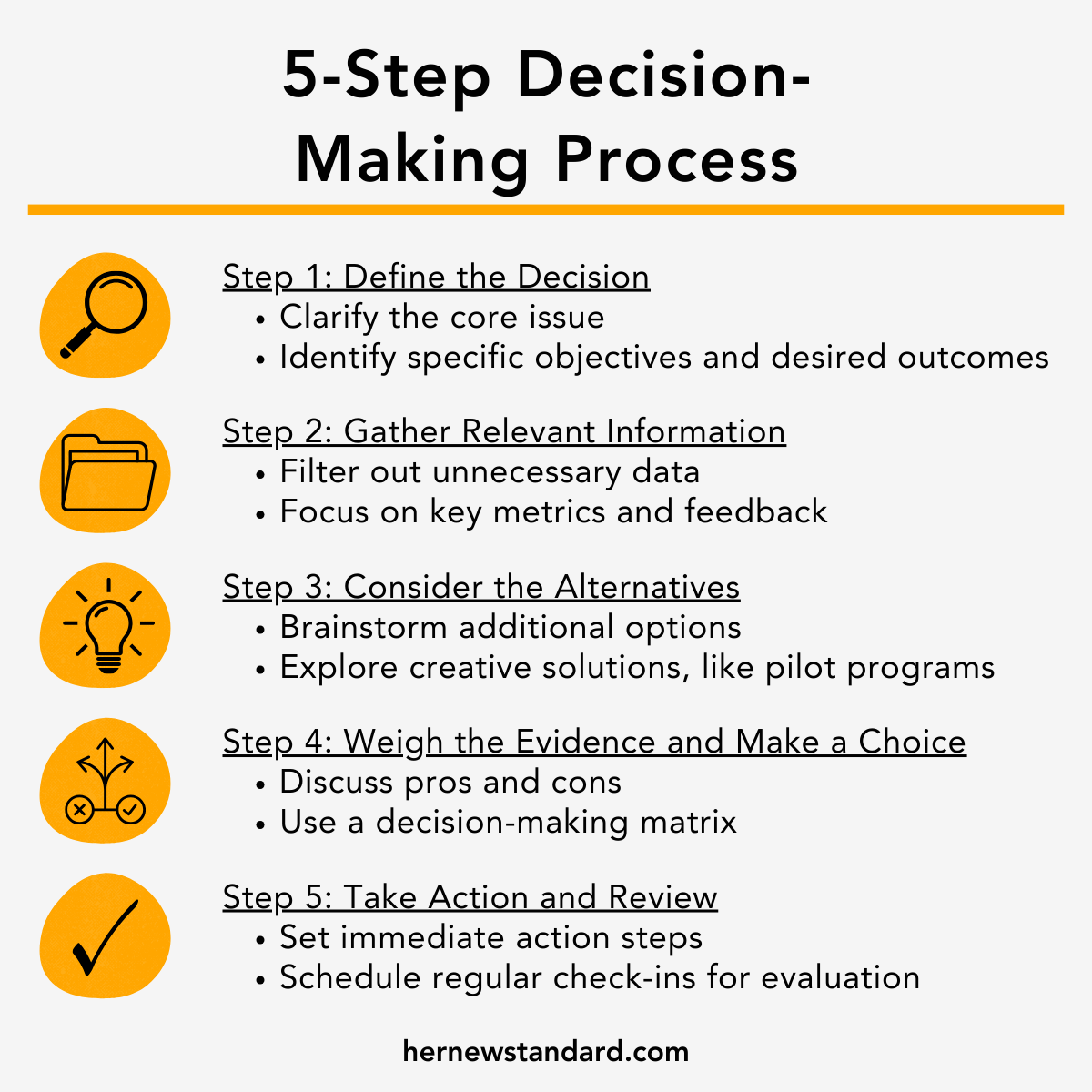Why Decision-Making Matters for Leaders
Every leader knows the weight of a critical decision—the late-night pondering, the endless what-ifs, and the pressure to get it right. From major acquisitions to team restructures, the choices you make drive progress, build trust, and shape the organization’s future.
The best leaders cut through complexity, weigh risks, and commit to action—even in uncertain conditions. But even seasoned leaders can fall into decision traps like burnout or data overload. These missteps ripple through an organization, impacting not only outcomes but team morale and trust. To avoid these pitfalls and lead with clarity, confidence, and speed, sharpening decision-making skills is essential. In this post, we’ll explore practical strategies to strengthen this critical leadership competency and drive better outcomes.
3 Common Decision-Making Pitfalls and How to Avoid Them
Even the best leaders can get caught in decision-making traps that undermine clarity and impact. Here’s a look at three common pitfalls—and how you can sidestep them to make sharper, more confident decisions.
1. Decision Fatigue: When Your Brain Is Running on Empty
Decision fatigue sets in after making a series of choices, leaving you mentally exhausted. Leaders often face a constant stream of decisions throughout the day, and by the time you reach the most critical ones, your mental energy is often depleted.
The result? You default to impulsive choices or delay critical decisions until the last minute.
Solution:
- Prioritize High-Impact Decisions: Tackle the big, game-changing decisions early in the day when your mind is sharp. Save routine or less important tasks for later.
- Automate or Delegate Routine Choices: Offload trivial decisions like scheduling or meal planning to free up your mental bandwidth for strategic thinking. Tools, systems, and delegation can take these off your plate.
2. Multitasking: The Productivity Killer in Disguise
Many leaders think multitasking is a badge of honor, but studies show that it can reduce productivity by up to 40%. When you divide your attention between multiple tasks, your decision-making quality plummets.
Solution:
- Block Time for Deep Work: Dedicate specific periods of your day to focus on high-priority tasks without interruptions. Techniques like the Pomodoro method (25 minutes of focused work, followed by a short break) can help you maintain concentration.
- Eliminate Distractions: Silence notifications, avoid unnecessary meetings, and carve out an environment conducive to deep work.
3. Analysis Paralysis: The Information Overload Trap
With access to endless data and insights, it’s easy to get stuck in analysis paralysis. You gather more and more information, but the decision never gets made. The longer you wait, the more overwhelming it feels.
Solution:
- Set Time Limits for Research: Be disciplined about how much time you spend collecting data. Limit your research to key sources, and trust yourself to make informed decisions without all the data available.
- Seek External Input: If you’re overwhelmed, a trusted colleague can provide fresh perspectives and help cut through the clutter.
A Step-by-Step Decision-Making Process for Leaders
If you want to consistently make better decisions, following a clear process is key. Here’s a simple 5-step decision-making process that you can apply as a leader:
Real-World Examples of Decision-Making Challenges
During a recent HNS program, we worked with a Director of Operations from a leading financial institution who was facing a tough decision: whether to reorganize her team structure to improve efficiency.
This was a significant decision involving team realignment, potential layoffs, and budget considerations. The pressure of making the “right” call led her into a state of analysis paralysis, where every possible outcome felt like a risk, and the inability to decide was causing her significant stress.
As she explained the dilemma, several other women in the group nodded knowingly, having faced similarly high-stakes decisions. Together, we walked through the situation using the 5-step decision-making process to break it down and provide clarity. Here’s how it worked:
- Define the Decision: First, we helped her clarify the core issue—was the real problem team efficiency, or was it related to budget constraints? Narrowing the focus allowed her to clearly define that her goal was to improve productivity and collaboration across departments, rather than simply cutting costs.
- Gather Relevant Information: She was feeling overwhelmed by too much information, so we helped her filter out the noise. With some probing, she identified the most relevant data—past team performance metrics, feedback from direct reports, and the specific needs of her clients. This eliminated the less important details and allowed her to focus on the facts that truly mattered.
- Consider the Alternatives: Initially, she thought there were only two options—reorganize or maintain the status quo. As a group, we brainstormed additional alternatives, such as testing a pilot program with smaller changes to the team structure or using temporary consultants to fill gaps before committing to a full reorganization. This widened her options and eased the pressure.
- Weigh the Evidence and Make a Choice: We worked together to weigh the pros and cons of each option. By discussing the long-term implications and using a decision-making matrix, she was able to objectively see which choice aligned best with her strategic goals. Ultimately, she decided to start with a pilot program, allowing for adjustments based on real-world feedback.
- Take Action and Review: By the end of the session, she felt confident and empowered to move forward. She set immediate action steps, including meetings with key stakeholders and a timeline for evaluating the pilot program’s success. We also discussed setting up regular check-ins to review the outcomes and make any necessary adjustments along the way.
By applying this 5-step process, she moved from feeling stuck in indecision to having a clear action plan. The relief was palpable, and she left the session with a renewed sense of confidence, knowing she had a structured approach for making impactful decisions in the future.
Common Decision-Making Styles
Every leader has a unique decision-making style, and recognizing yours can significantly enhance your leadership effectiveness.
- Analytical: Focuses on data and facts but can suffer from analysis paralysis.
- Intuitive: Relies on gut feelings, which can be effective but may miss critical details.
- Collaborative: Seeks input from others, which can enhance decision quality but slow the process.
To help you sharpen your skills, we’ve created one comprehensive guide that covers these three most common decision-making styles, including insights into each style’s strengths and challenges, along with practical tips to make better, faster decisions.
Download the guide now and take your decision-making to the next level.

Decision-Making Lead Magnet
Recommended Resources for Women Leaders
To further sharpen your decision-making skills, here are some recommended books and podcasts:Books
- The Confidence Code by Katty Kay & Claire Shipman
Strengthen your decision-making abilities by understanding the psychology of confidence. This book provides actionable insights for overcoming hesitation and making bold, impactful choices. - How Women Decide: What’s True, What’s Not, and What Strategies Spark the Best Choices by Therese Huston
Explore the unique ways women approach decision-making and how to navigate biases and external pressures while maintaining leadership effectiveness. - Radical Candor by Kim Scott
Learn how honest communication and direct feedback are key to making hard decisions while maintaining team morale and productivity.
Podcasts
- The Next Women: Inspiring Women Leaders
Interviews with female entrepreneurs and executives discussing their decision-making journeys, providing real-world examples and inspiration for leaders in all industries. - Coaching Real Leaders
Gives listeners an inside look at executive coaching sessions with high-level leaders facing real challenges. Muriel Wilkins helps leaders navigate tough decisions and refine their approach, offering practical insights for professionals aiming to elevate their leadership skills.
Ready to enhance your decision-making and leadership impact?
Enjoyed this post? You might also like…












